Spin champion offers advice to recover from unusual attitudes
Californian Spencer Suderman set the world record for 98 inverted flat spins in his Sunbird S-1x biplane, so he knows a thing or two about unusual attitudes. AOPA caught up with the airshow performer at the Camarillo Fly-In April 29 to ask how pilots could benefit from unusual attitude training to increase their confidence and ability to handle the unexpected.

Unusual attitudes
Suderman said that learning how to become comfortable in unusual attitudes is an important aspect of flying. “You have to keep in mind that airplanes operate in a three-dimensional environment and most flight training only focuses on two dimensions” but not on “what you might think of as the Z-axis, the vertical axis and of being upside down and right side up.” A student of Suderman’s was affected by wake turbulence and sought out the inverted spin specialist to better understand how to properly recover in the future. “He did exactly the wrong thing, which was trying to pull through [the incident] rather than push the yoke forward and try to roll out of it.”
Base-to-final turn
“Still to this day we have people doing the classic base-to-final turn stall-spin catastrophe.” Suderman said pilots could have a better understanding of that phase of flight if they experienced proper spin-training techniques with an instructor specializing in spins and spin recovery. A critical piece of the puzzle is for pilots to “recognize the onset and incipient phase of a spin and prevent it through proper and immediate recovery technique. Essentially, it’s get everything neutralized, and get off the rudder that is causing you to yaw the airplane in the first place. Look, when you are at 500 feet doing the base-to-final turn, you don’t have time to let the spin develop. You need to stop it before it starts,” he explained.
“Learning unusual attitude training, including spins, will teach pilots that this is what happens beyond the edge. Most flight training focuses on avoidance without giving you the experience of what happens beyond the event.”
Comfort in the airplane
“If you learn unusual attitudes you will be comfortable when there are unknowns. When you don’t know what it’s like to be upside down in the airplane, you are fearful. If you can actually do it in a controlled environment, with a properly well-trained instructor, and in the right airplane, you will never be uncomfortable because you know what happens, you know what it means, you know what it feels like—and more importantly—you know how to fix the problem,” Suderman said. “It’s instinctual.”
Proficiency
“Learning how to fly the airplane through the use of all the flight controls” is another key. “I would say that [some] people never really get the full impact of what each individual flight control does. When you learn unusual attitudes and aerobatics, you have maneuvers that you train with that focus on each individual flight control,” said Suderman. “Think about this for a second—when you start rolling into a knife-edge and 90 degrees of bank, now the rudder is acting more like the elevator, and the elevator is more like a rudder” because the aircraft is on its side. “When you understand that dynamic, you inherently become a better pilot because you develop these insights and perceptions about how airplanes really fly.”
Learning aerobatics is fun
“You get to a point where you’ve been to every airport within 200 miles of your base and you may get a little bored but if you learn to fly aerobatics for fun you don’t have to go anywhere,” Suderman explained. “You just have to take off and go to the nearest aerobatic practice area and literally just fly around up and down—and take yourself for a spin! Just have fun in the airplane and you’re becoming a better pilot at the same time.”
Suderman deployed advanced mathematical algorithms and a considerable amount of planning and technical expertise for his March 2016 inverted spin record. He is contemplating an attempt to break his own record if he can obtain specialized equipment that would enable a higher climb than his previous 24,500 altitude required to accomplish the feat.



